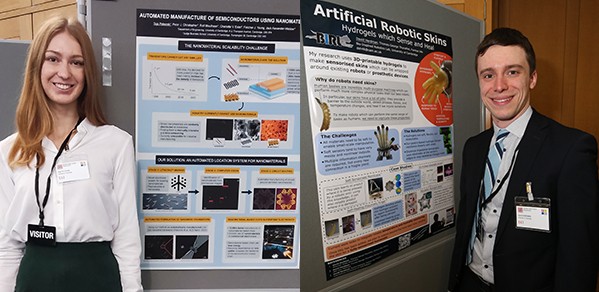
PhD students Teja Potočnik and David Hardman showcased their engineering research at Parliament to a range of politicians and a panel of expert judges, as part of the STEM for BRITAIN poster competition.
These early career engineers are the architects of our future and STEM for BRITAIN is politicians’ best opportunity to meet them and understand their work.
Stephen Metcalfe MP
The competition, which is open to early stage or early career researchers and is the only national competition of its kind, saw Teja and David join dozens of other researchers shortlisted in the engineering session of the competition, with a chance to win a gold, silver or bronze prize.
Teja is a PhD student in the Low-Dimensional Electronics Group, based in the Department’s Division of Electrical Engineering.
At Parliament, Teja presented her research poster titled Automated manufacture of semiconductors using nanomaterials. In it she demonstrated the ‘nanomaterial scalability challenge’ – how to tackle the manually-intensive and time-consuming task of integrating nanomaterials into electronics so that they can be scalable for industrial manufacturing.
Nanomaterials are 1,000 times smaller than the width of a human hair, and nanomaterial-based electronics offer additional functionalities for a variety of novel applications, including transistors, sensors, LEDs and lasers.
Teja’s solution, in collaboration with colleagues from the Department of Engineering and the Cambridge Judge Business School, is to use an automated system that makes nanomaterials manufacturing 12,000 times faster than what is currently being done at research scales, enabling manufacturing with nanomaterials for commercial applications.
“It will allow for large-area nanomaterial identification and property analysis, which is useful not just for integrating nanomaterials into other systems but for nanomaterial research in general,” said Teja. “Nanomaterials have a range of interesting properties due to their low dimensionality.”
She added: “It was exciting to present my research in Parliament. I liked talking to people outside of my research field as it made me think about the problem from a different point of view. It was also very interesting to see other posters and the fascinating research that everyone is doing.
“I developed these techniques to make nanomaterial devices scalable, and now I am looking to develop these further as a tool to help researchers and semiconductor manufacturers to use nanomaterials. I am also trying to commercialise my research, and I have been working with Cambridge Enterprise and participating in its Founders programme, which has been an excellent support in turning my research into real-world applications that will benefit others.”
David is a PhD student in robotics, based at the Department’s Bio-Inspired Robotics Laboratory.
At Parliament, David presented his research poster titled Artificial robotic skins – hydrogels that sense and heal. In it he demonstrated the challenges, solutions, and case studies of 3D-printable hydrogels. These hydrogels can be used to make sensorised skins that can be wrapped around existing robots or prosthetic devices.
The sensorised hydrogel can respond to human touch, detect bending and stretching, and can monitor temperature and humidity. The aim is to make robots that can perform the same range of tasks as humans by replicating the properties of human skin.
“I work on the design and implementation of artificial skins that can be added to existing robots or prosthetics to give them the same functionalities than our skin gives us,” said David. “Our skin has a lot of jobs: it provides a barrier to the outside world, detects presses, forces, and temperature changes, and heals if we injure ourselves.”
He added: “I use a piezoresistive (conductivity changes in response to applied strain) and healable hydrogel to make these artificial skins. As these materials get better and better, we can use them to sense larger areas and more complicated shapes, ultimately creating a skin for a fully-sensorised humanoid.”
Commenting on the competition itself, David said: “STEM for BRITAIN was a great opportunity for me to see some of the cutting-edge engineering work in the UK, and to discuss my robotic sensor research with MPs and decision-makers. I had some fascinating discussions, which has given me lots to think about as we move forwards with this work.”
Stephen Metcalfe MP, Chairman of the Parliamentary and Scientific Committee, said: “This annual competition is an important date in the parliamentary calendar because it gives MPs an opportunity to speak to a wide range of the country’s best young researchers.
“These early career engineers, mathematicians and scientists are the architects of our future and STEM for BRITAIN is politicians’ best opportunity to meet them and understand their work.”
The Parliamentary and Scientific Committee runs the competition in collaboration with the Royal Academy of Engineering, the Royal Society of Chemistry, the Institute of Physics, the Royal Society of Biology, The Physiological Society, The Nutrition Society and the Council for the Mathematical Sciences. Sponsorship is provided from Dyson, Clay Mathematics Institute, United Kingdom Research and Innovation, Warwick Manufacturing Group, AWE, the Society of Chemical Industry, Institute of Biomedical Science, the Heilbronn Institute for Mathematical Research, the Biochemical Society and the Isaac Newton Institute for Mathematical Sciences.
Adapted from a STEM for BRITAIN press release.

